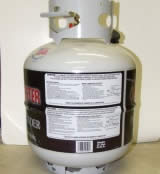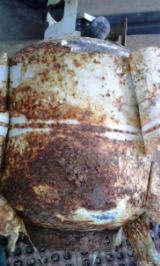Propane Cylinder Sleeves - Moisture, Rust and Damage
Five gallon propane cylinders are the most common cylinders used today in the consumer LP Gas bottle market. These bottles are easily spotted hooked to grills and in cylinder exchange cabinets outside grocery stores, hardware stores and convenience stores. Even sporting goods retailers stock and sell these 20 pound bottles that can easily be found in camping sections of the stores. All of these bottles come from the manufacturer wrapped in a plastic sleeve. Cylinder re-fillers that stock bottle exchange cabinets utilize these plastic sleeves to communicate safety and operational information. These plastic sleeves have recently become a point of issue for the propane industry.
Propane Bottle Sleeves - Necessary Documentation

Propane cylinder sleeves contain very useful information that should be carefully read. Basically, a cylinder sleeve is the documentation for the propane bottle, on the bottle. Warnings include general dangers of LP Gas, proper cylinder storage, disposal information and safe propane bottle use. Cylinder sleeves also include directions for connecting cylinders to appliances, regulator vent position, checking for leaks and reference to following gas appliance manufacturers instructions for use. The placement of this documentation is excellent as consumer propane cylinder users can't help but see it plainly. It's generally on two sides of the cylinder in both english and spanish with graphics that clearly help users understand the features and operation of the gas valve. However, this information is printed on material that will compromise the integrity of the cylinder and shorten its useful life, if not endanger the user.
Propane Cylinder Sleeves - Issues

Although cylinder sleeves instruct the owner to "Remove Sleeve Before Use", most consumers don't really pay attention to this vital instruction because chances are, none of the documentation on the sleeve was read in the first place. Consumers simply hook the propane bottle to the grill and "fire it up". After all, they've been doing it that way for as long as they can remember.
The problem with propane cylinder sleeves is this; Cylinder sleeves are made of a plastic, shrink wrap type of material. Any moisture between the sleeve and the cylinder is trapped, with no where to go. The problem is further magnified when the cylinder is used in the operation of an appliance, such as a grill. During use, propane cylinders and tanks can form condensation on their exterior surface when outside humidity is high enough to support it. When condensation forms on a sleeved cylinder, the moisture is trapped and held against the metal surface of the bottle. We are all familiar with what water does to metal and this resulting rust can destroy the cylinders exterior. Propane bottle sleeves further accelerate this damaging process by not allowing the moisture to evaporate. The moisture is held against the bottle with no means for escape. Pictured left (courtesy of Jay Johnston and Associates - The Safety Leader) is an example of the damage propane cylinder sleeves can cause when they are not removed.
